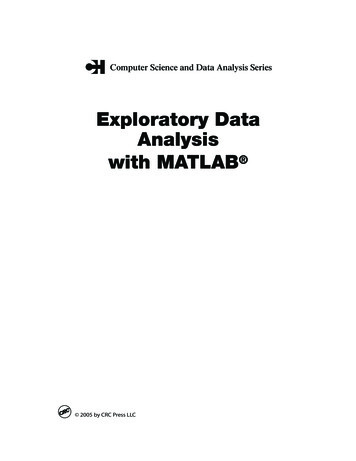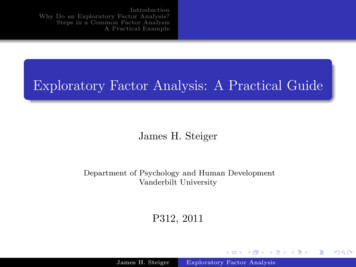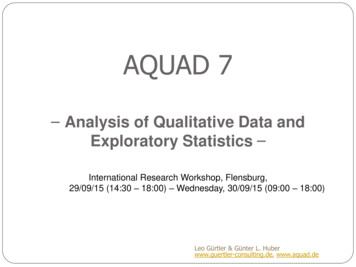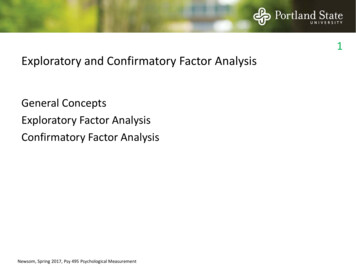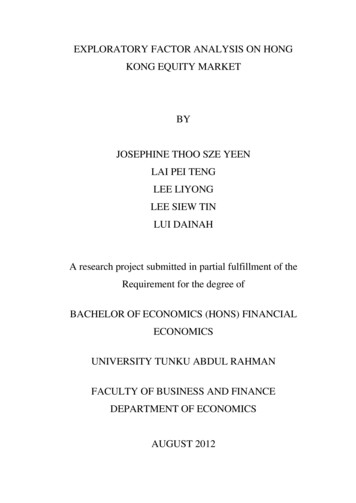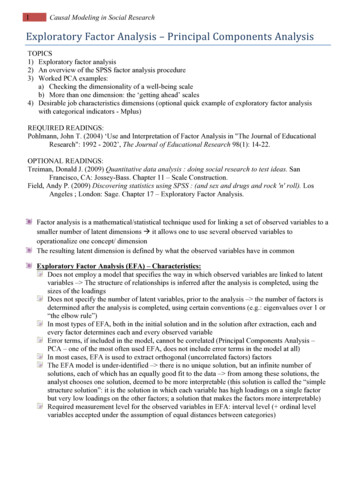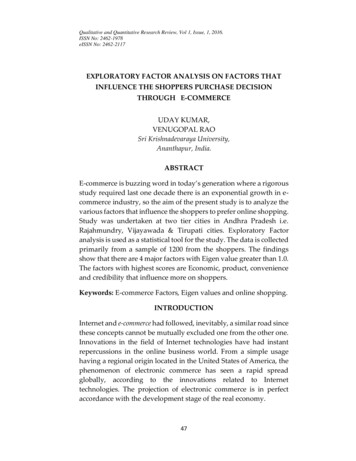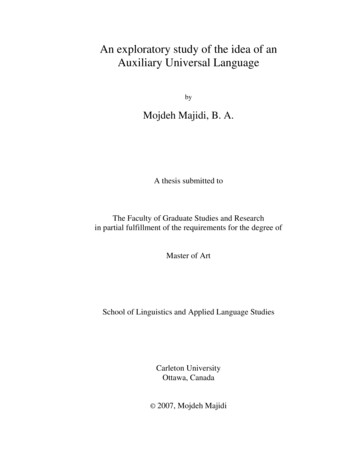
Transcription
An exploratory study of the idea of anAuxiliary Universal LanguagebyMojdeh Majidi, B. A.A thesis submitted toThe Faculty of Graduate Studies and Researchin partial fulfillment of the requirements for the degree ofMaster of ArtSchool of Linguistics and Applied Language StudiesCarleton UniversityOttawa, Canada 2007, Mojdeh Majidi
AbstractWe live in an increasingly interconnected world where the growing movements ofideas, goods, information, money and people across national boundaries andtechnological advancements have led to the urgent need to have a common secondarylanguage to partake in the global community. This study intends to extend the literatureon the idea of an Auxiliary Universal Language (AUL), to explore the features of anAUL, and to discuss the rationale and feasibility of language planning of an AUL. It is inaddition my intention to try to find answers for how it can actually be planned throughinternational planning.To explore the idea of an AUL and answer the research questions I used tworesources. First, after re-examining the literature and extending the literature onLanguage Policy and Planning I present a tentative model for language planning of anAUL. Second, to strengthen the conclusions from the first resource I conducted two setsof interviews to find out how my research participants who were thirteen graduatestudents in School of Linguistics and Applied Language Studies at Carleton Universitycould contribute to this exploratory study.ii
AcknowledgmentsI would like to express my gratitude to all those who gave me the possibility tocomplete this thesis. First, I would like to express my deepest gratitude to ProfessorLynne Young for supervising my study, providing constructive feedback and offeringdirection whenever I needed it. She encouraged me and gave me the support andconfidence to accomplish my Master’s degree, which seemed impossible when I firststarted this journey. I would also like to acknowledge the illuminating lectures ofProfessor Eve Haque on different issues involved in Language Policy and Planning thatgave me new insights on how to address my research questions. Also I would want tothank her for agreeing to be on my thesis committee. I would also like to extend mygratitude to Professor Graham Smart who agreed to be on my thesis committee. I wouldalso like to thank Professor Natasha Artemeva who not only broadened my view oflanguage and language use in society, but also helped me to believe in myself and pursuemy passions to do research. I am also grateful of Mr. Jaffer Sheyholislami whosequestions and concerns about the subject of the thesis deepened my understanding of it. Ialso thank the research participants whose ideas supplement my exploratory study. I amalso grateful of my father and my mother whose support and encouragement has alwaysbeen there, in particular my mother who over the last ten years has always been with mein spirit. I would like to give my special thanks to my husband Ramin Malakoti whoseinsightful opinions about the subject of my thesis and also his support, patience,encouragement and love enabled me to complete this work.iii
Table of contentsAbstract . . . iiAcknowledgement . iiiTable of contents . iv1 INTORODUCTION . .12 LITERATURE REVIEW . . 82. 1 Introduction 82. 2 Reviewed resources . 102. 2. 1 The literature on AUL itself . . 102. 2. 2 Esperanto 352. 2. 2. 1 History of Esperanto . 352. 2. 2. 2 The literature on Esperanto .402. 2. 3 English . . . 462. 2. 3. 1 Positive views .472. 2. 3. 2 Mixed views 532. 2. 3. 3 Negative views 602. 2. 4 Language Policy and Planning . . . 823 SEARCHING FOR ANSWERS . . 1053. 1 Introduction 1053. 2 The research participants . 1083. 3 Re-examining the literature 1103. 3. 1 Answers to the first research question .1113. 3. 2 Answers to the second research question . 1253. 3. 2. 1 Answers from the literature on AUL . . . .1263. 3. 2. 2 Answers from the literature on English 1303. 3. 2. 3 Answers from the literature on Esperanto 1313. 3. 2. 4 Answers from the literature on Language Policy and Planning.1343. 3. 2. 4. 1 A tentative model for the language planning of an AUL 1351) Status planning .1352) Corpus planning 144iv
3) Education planning . .1453. 4 Interviews .1543. 4. 1 The first set of interviews . 1563. 4. 2 The second set of interviews (follow-up questions) . .1744 CONCLUSION . .1874. 1 Concluding remarks . 1874. 2 Limitations of the study and directions for future research . 198References 203Appendix A: The Bahá’í perspective on an AUL. . 210Appendix B: The first set of interviews . . . 220Appendix C: The second set of interviews (follow-up questions). .221v
Chapter 1: IntroductionWe live in an era in which societies are not any longer isolated (De Swaan, 2001).Although “intercultural contacts are as old as humanity itself”, in the last two or threedecades they have extended and increased to such an extent that we cannot imagine theworld without these social, economic, and political interconnections (Hofstede, 2001, p.423). And there is an increasing need and desire to be part of this network ofinterconnection and to be a member of the global community whether as an individual oras a collective, although this membership has a more material and economic aspect to itthan a moral or spiritual one. As Tomlinson (1999) puts it, local life is increasingly tiedup with “global structures, processes and events” in order to be part of the globaleconomy (p. 25).In the last few decades we have witnessed the fact that the diverse range of humanaffairs has gained a global aspect so that different social, economic, and political issuestied to human life are not any longer individual or even national issues but global mattersthat need to be discussed in the global arenas. And of course technology and materialadvances, in particular communication technologies, have had a tremendous role incontributing and giving rise to global interconnection, and also in facilitating it in termsof providing both live and virtual communication in which geographical and politicalboundaries are blurred and further communication with people at the other side of theworld is not any longer a dream. As Dunn (1995) puts it, “the technologies have broughtonce remote regions of the world into on-going daily contact, in effect dramaticallycontracting old conceptions of time and distance” (p. xi) so that politically definedgeographical boundaries are becoming less important.1
But the question is how can we actually participate in those interconnections?What can be the best means or tools to be able to go beyond our speech community andfulfill different communicative purposes both as an individual and as a collective withother individuals or collectives? The fact is that these “relations of power, trade,migration and cultural exchange” in which “all human groups on the globe engage”, or atleast try to engage, are “necessarily embedded in language,” which is the most significantand frequently used means of communication among human beings (De Swaan, 2001, p.177). But how many languages should or could we learn to fulfill our differentcommunicative purposes? Can we learn all the world languages or at least those differentlanguages that we need? Or should we spend an enormous amount of time and energy ontransplanting information into almost 6912 languages in the world as last estimated in2005 by Ethnologue, which is an encyclopedic reference work cataloging all of theworld’s living languages? Even if we could, that would be very difficult and would implyinvesting a large amount of human and financial resources. Another option that has beensuggested by many philosophers and linguists from the seventeenth century (e.g.,Descartes 1629 and Montesquieu, 1728 as cited in Brown, 1991) to the present (e.g.,Sapir, 1925; Lauwerys, 1946; Pei, 1968; Phillipson, 1992; Eco, 1995; Harrison, 2000;Meyjes, 2006) is that an Auxiliary Universal Language (AUL) could be adopted to solvethe problem of language barriers, a common language that everyone in the world couldlearn as auxiliary or secondary to his or her mother tongue to be able to communicatewith speakers of other languages. In fact, as argued in the literature, adoption of an AULwould be the solution to the problem of the language barrier facing every human being, inparticular at the present time in human history.2
But the question is what the features of an AUL are. Do we already have an AULthat has those features? If not, should we get one? And how can we do it? It was theseconcerns that initially encouraged me to dedicate my master’s thesis to exploring the ideaof an AUL in which I made an attempt to answer two research questions: 1) what is anAUL and what is its main purpose? 2) What is the best possible method to adopt an AULand implement it globally?And of course I have to mention that as a Bahá’í individual, long before doing mymaster’s thesis on exploring the idea of an AUL I read about the idea of an AUL asemphasized in The Kitab-i Aqdas, which is the holy book in the Bahá’í Faith, and otherBahá’í writings. And in fact, it was the Bahá’í writings on the idea of an AUL that firstinspired me to begin this study. I realized, however, that I needed to stand back anddistance myself from the study to be sure I was being thoroughly self-reflective, I decidedthat it was necessary to separate the Bahá’í writings from the other research by puttingthe former into a separate section, Appendix A.Since this exploratory study was a learning process, I would go through one stageand then realized the need to go to the other stage. When I first started the study, to findout what had already been said with regard to the idea of an AUL, its nature, its purposeand the plan to have one I reviewed the literature. There were four different thoughinterconnected resources that I reviewed. They were different in the sense that eachdiscussed and shed light on the different aspects associated with the idea of an AUL. Andthey were interrelated in the sense that if viewed as a whole, they could provide a holisticpicture of the idea of an AUL in which different issues involved in it are more or lessdiscussed.3
The first set of resources in the literature review I focused on was on the idea ofan AUL itself. Through reviewing this set of literature I intended to find out what hadbeen already said with regard to the definition of an AUL, its functions, its purpose andalso its means of adoption. As a second resource, I reviewed the literature on Esperantobecause I realized that most often in the literature on AUL scholars promoted the ideathat constructed languages be adopted as an AUL instead of a natural one and referred toEsperanto as the most well-known constructed language that is still live and hasthousands of speakers all around the world. So, not only did I want to know more aboutEsperanto itself, but also I wanted to know what its status was as an AUL.After reviewing these two sets of literature, in particular the literature on AUL Irealized that in many cases scholars focused on the choice of an AUL and about whetherit should be a current natural language or a constructed one, rather than providing acomprehensive discussion of the idea of an AUL itself. In addition, I found that althoughthey talked about an AUL as something desirable and beneficial for human beings, only afew of them discussed though briefly how it could be adopted or how we could have anAUL. Therefore, as a result of the review I realized that although the idea of an AUL haslong been the subject of discussion in academia, it has never been fully examined, whichis another reason for my exploratory study.In the process of reviewing the literature I also realized that another research issuethat I needed to address would be whether English is an AUL or not. While I wasreviewing the literature on AUL I came across many arguments that English is notsuitable to become an AUL and that having it as an easy fix for the language barriers inthe world would not solve the problem fundamentally. However, I found that contrary to4
such arguments and oppositions English is already wide spread and is the only languageknown as an most international language at the present. So, I wondered if English wasactually an AUL or not. Did it have the qualities and features expected of an AUL asdescribed in the literature or not? Thus I reviewed the literature on English as anInternational Language (EIL) in an attempt to gain a clear picture of the status of Englishto be able to identify the problems associated with the current situation of English as wellas a possible solution if there is any. In fact, I had the impression that discussing the ideaof an AUL, in particular its international planning, would be logical, acceptable anduseful if there was a problem with the current situation of English as an AUL. Afterreviewing the literature on English, I found that there were so many critical views aboutEnglish and that the literature strongly suggested that there were many problemsassociated with English spread and the forces that have contributed to its dominance.However, similar to the scholars in the first set of the literature, the scholars in this fieldexcept for a few (e.g., Pennycook, 1994, 1995; Phillipson, 1992, 2001) did not provide asolution to solve the numerous problems associated with English spread although theyquestioned the status of English as an international language and presented a thoroughdescription of the negative aspects associated with it.Therefore, after reviewing the literature I realized that there is still a huge gap inthe literature in terms of how the problem of language barriers can actually be removedthrough international planning and decision-making. I also realized that the answer to thisquestion could actually be an answer to the increasing need to be able to communicateglobally, which is now partially fulfilled by English, a language that is largely perceivedas the language of modernity, social and economic development and thus prosperity5
compared with native languages that are increasingly losing their functions and value inthe face of English. In fact, reviewing the literature on EIL led me to the view thatalthough English may act as an AUL, its status and means of spread are not in accordancewith what the scholars describe as the features of an AUL, it’s uncontrolled dominance isa threat to people’s linguistic rights to learn and use their native languages as well as tocultural diversity which is of great importance for sustainable social and economicdevelopment and thus advancement of human civilization.In an attempt to investigate how an AUL could be adopted through internationalplanning I also reviewed the literature on Language Policy and Planning (LPP). Iintended to find out whether scholars in that field had ever discussed the LanguagePlanning (LP) of an AUL. What I found were a few brief references (Haugen, 1972 andTauli, 1974) to the LP of an AUL as a branch of LPP. However, none of them provided athorough discussion of the issue.Therefore, in order to explore the idea of an AUL further and answer the researchquestions, as the first approach I re-examined the literature itself and extended theliterature on LPP. In fact, I looked at the literature to put together bits and pieces that hadbeen presented in different fields as a way to define an AUL, identify its purpose anddiscuss its international explicit planning. I used LPP as a framework and presented atentative plan for the LP of an AUL. As a second approach, to strengthen the answersprovided by the literature and to get some ideas from educated fellow students involvedin EIL by virtue of being students in SLALS – where language in use receives so muchfocus – I conducted interviews with thirteen graduate students in SLALS at CarletonUniversity. In the first set of interviews (Appendix B), I focused on ten student6
participants’ views about EIL, which led to the idea of an AUL in general and askedabout how an AUL could be adopted. In the follow-up questions (Appendix C) I mainlyfocused on the LP of an AUL that had turned out to be the main gap in the literature andinterviewed three other students who had some explicit knowledge of LPP as well associal planning in general.In Chapter 2, first I will review the literature on AUL focusing on four sets ofliterature: 1) the literature on AUL itself, 2) the literature on Esperanto, 2) the literatureon EIL, and finally 4) the literature on LPP.In Chapter 3, “Searching for answers”, I will use two sets of resources - theliterature and the interviews - to answer to the research questions. First, I will re-examinethe four sets of literature and then extend the literature on LPP as a model and apply it tothe language planning of an AUL and discuss different aspects associated with it.Second, I will review the interviews and analyze them to find out what the researchparticipants contributed to the idea of an AUL.In Chapter 4, I will briefly restate the purpose of the study, the research questions,and the two approaches adopted to explore the idea of an AUL. Then I will drawconclusions about the findings. I will end with limitations of this exploratory study andsuggest some directions for future research.7
Chapter 2: Literature review2. 1 IntroductionIn my search to find what has already been done or discussed on the idea of anAuxiliary Universal Language (AUL), I learned that since the seventeenth century theidea of an international language has been the theme of discussions in many academicbooks and articles that I will review in the following paragraphs.When I first started to search and study the resources on the idea of an AUL, Iused different key words such as “universal language”, “global language”, internationallanguage”, “common language”, and “auxiliary universal language”. Indeed, my choicesof the key words were based on the fact that I realized that there is not only one term usedby scholars to define the idea of an AUL. “Global language” (Crystal, 1997),“international language” (e.g., Crystal, 1997), “an international auxiliary language” (e.g.,Eco, 1995; Sapir, 1925) and “an artificial international language” (Jespersen, 1928) aresome of the terms that I encountered while reviewing the literature on an AUL. What allthese terms seem to share is the notion that an AUL is the language through which peoplefrom different linguistic and cultural backgrounds from all around the world cancommunicate and exchange ideas. It is the language that can remove one of the mostproblematic issues in human life, the language barrier. However, these terms differ in thesense that each refers to a different language or a different kind of language as an AULand thus each discusses the idea of an AUL from a different perspective and sheds lighton different aspects of an AUL. For example, when Crystal (1997) talks about aninternational language he explicitly refers to English. Sapir (1925), on the other hand,8
uses the terms “an international auxiliary language” to refer to and promote constructedlanguages rather than a natural language to be adopted as an AUL.Based on the different terminology that I found in the literature and what scholarshave considered as an AUL, why and how such a language can be adopted and spreadand what should be its main characteristics, I learned that the scholarship could becategorized into three groups. Scholars in the first group (e.g., Sapir, 1925; Jespersen,1928; Eco, 1995; Harrison, 2001) talk about the idea of an AUL in general. They promoteit as something that is theoretically desirable and thus beneficial to solve the problem oflanguage barriers. Focusing on the choice of an AUL, the majority of them emphasizesand discusses the advantages of artificial or constructed languages compared with naturallanguages. In the second group the scholars (e.g. Reed, 1968; Janton, 1993, Eco, 1995,Li, 2003) specifically focus on Esperanto as the most famous constructed languageinvented to be used as an AUL.The third and largest group of resources examines EIL. Contrary to Sapir’s (1925)prediction, which I will shortly review, it now is evident that English is the most widelyused language in technology, science, academia, trade and even every day life all aroundthe world and it is the only language known as an international language. Thus, in the lastfew decades scholars have examined aspects related to English as an internationallanguage rather than specifically the idea of an AUL itself. These scholars can be dividedinto three groups based on their approach towards English: positive views, negativeviews and mixed views. First I will review the ones who have positive or liberal viewstowards English such as Kachru (1992) and Canagarajah (2000); that will be followedwith scholars (e.g. Crystal, 1997, 2000; Graddol 1997) who have mixed ideas towards9
English. And finally, I will review the scholars such as Phillipson (1992, 2000) andPennycook (1994, 1995) who have critical views about English.In addition to the literature on the idea of an AUL I will also review the literatureon LPP as a general framework that can be extended and used to promote and adopt anAUL. In fact, the activities involved in LPP that are mostly focused on policyformulations and implementations at the national level can be extended and used as amodel to select a language to have the status of an international language that is auxiliaryto the mother tongues through international decision and agreement.2. 2 Reviewed resources2. 2. 1 The literature on AUL itselfThe first group of the resources that I am going to review includes the literatureand the scholars who have examined the idea of an AUL in general. I should mention thatthe majority of the scholars, in particular those in 1920s to 1960s, have focused onartificial or constructed languages as the best possible solution for the selection of aninternational language and have discussed their benefits compared with naturallanguages.Sapir (1925) is the first scholar whose opinions on the idea of an AUL I am goingto review. As a well-known linguist he examines the idea of an AUL in his article, TheFunctions of an International Auxiliary Language. He begins his discussion of an AULby referring to the point that there is little difference of opinion in the theoreticaldesirability of an international auxiliary language. However, he notes that there aredifferent opinions in terms of the factors that should be taken into account in the solutionof language barriers in the world. Considering the expected functions of an international10
language he argues the point that adopting English as a quick and easy fix to facilitate the“growing need for international communication” (p. 1) does not solve the languagebarrier because it will be “at the expense of all other languages” and it may not be “abroad base” for “every type of expression of human being” though it can fulfill the“exigencies of trade and travel” (p. 2). Unfortunately he does not explain in detail thereasons for the inadequacy of English as a broad base. In addition, he argues that not onlyEnglish but also no national language should serve such a role because “no nationallanguage really corresponds in spirit to the analytic and creative spirit of modern times”(p. 6); however, a constructed language has such a simple structure and logic that nonational language even English can compete with it.Sapir’s (1925) second argument in favor of a constructed language deals with thepoint that psychologically people would have the “attitude of independence toward aconstructed language which all national speakers must adopt” because “it is foreign orapparently so to the traditions of all nationalities” (p. 6). And finally, he argues thatconstructed languages are culturally neutral.Jespersen (1928) also like his contemporary Sapir (1925) promotes the idea of aninternational language. Jespersen, who was a Danish linguist and English expert, hasmade tremendous contributions to the development of English grammar as well as theissue of adoption of an AUL. His book An international language, as he puts it, is a “pleafor an artificial international auxiliary language” (p. 1). Not only does Jespersenemphasize the need for an AUL as Sapir does, he also clarifies such a need by referring tomany situations where people feel language barriers as a serious drawback that do not11
allow them to “communicate freely with someone, ask questions, obtain or impartinformation, etc.” (p. 1).Unlike Sapir (1925) Jespersen defines what he has meant by the term an artificialinternational auxiliary language. His definitions in brief are: “Artificial” refers to alanguage that is “made consciously by one man or group of men opposed to naturallanguages which have been spoken for generations and whose development has chieflytaken place without the individuals being conscious of any changes” (p. 1).“International” means that the language is meant to be used “by individuals who thoughbelonging to different nationalities have something they wanted to communicate to oneanother” (p. 1). And the term “auxiliary” states that international language is “meant to beonly a sort of substitute for national languages whenever these are not capable of servingas means of communication” (p. 1). Such a language, he emphasizes, “should” not“supplant the existing languages” or “infringe the scared rights of the mother tongue”;however, it should be used “only when two or more persons ignorant of one another’slanguage had occasion to talk or to write to one another” (p. 1). In fact by defining anAUL Jespersen like Sapir promotes constructed or artificial languages in general.Lauwerys (1946) like Sapir (1925) and Jespersen (1928) but about twenty yearslater defends the idea of adopting an auxiliary language as a “matter of real urgency” (p.1). Lauwerys (1946) who was a Professor of Comparative Education has written manyarticles on issues such as international co-operation and understanding and comparativeeducation. And his interests in international co-operation and understanding have led himto discuss the subject of an AUL in the preface of the book On the Choice of a CommonLanguage by Jacob (1947). Like Sapir (1925) and Jespersen (1928), he promotes the idea12
of an AUL. However, his reasons are different from those raised by Sapir and Jespersen.Contrary to the previous scholars he views an international language not as auxiliary tomother tongues but as replacing them all because in his point of view linguisticdifferences are “merely stultifying” and thus do not make “life richer, subtler” and “morediversified” (p. 1). In other words, he argues that linguistic diversity has no benefit forhuman beings because it is the result of human beings being cursed since Babel, (anargument not likely to be accepted in academia and academic discourse). Linguisticdifferences between groups of human beings, as he maintains, are the sources offrustration because people cannot understand each other. He also emphasizes that acommon language is the instrument through which all nations can unite and remove theirconflicts; an important point that scholars before him seem to have failed to discuss.Indeed, he points out that “the second half of the twentieth century will be the period ofthe atomic engine and of atomic bomb” (p. 1). Thus, he argues that if nations intend tosurvive and achieve peace, “the symbol and instrument of their union must be a commonlanguage” (p. 1). Though he does not explain sufficiently how an AUL can be a means toachieve unity, his predictions seem to suit the present time in which having a commonlanguage is more urgent as one of the means to solve world problems.Stressing the importance of adopting an AUL in the world after the World War IILauwerys (1946) refers to obstacles that exist in the choice of which language shall beadopted as the “World Auxiliary” language (p. 1). The first of which, as he argues, is thatthough English is an “obvious candidate” due to large number of speakers and simplicity,it may not maintain its value by the year 2000 but he provides no reasons for thisargument (p. 2). In fact, similar to Sapir (1925) and Jespersen (1928) he argues that13
English as an accessible fix would not solve the problem of language barrier. As for thesecond obstacle, like Sapir (1925) he points out that English or any natural language isdifficult to learn compared with constructed languages. Thus, he adds to what Sapir andJespersen have already suggested that if an “ethnic language is to be universally adoptedas an auxiliary, it will have to be in simplified form” (p. 2). Explaining the advantagesand disadvantages of two simplified forms of English – Pidgin English and Basic English– he argues that Basic English has not been accepted by all English-speaking countriesspecially England. Lauwerys (1946) does not explain the reasons for the Basic Englishnot being accepted, but he briefly states, “a few critics seem to think that its adoptionwould confer undesirable advantages upon England and the U.S.A.” (p. 2). Then hecontinues “for the most part those who are interested in the
also like to thank Professor Natasha Artemeva who not only broadened my view of language and



